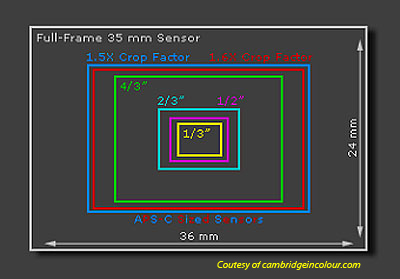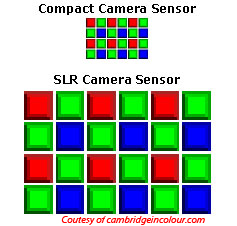The Digital Sensor: A Guide to Understanding Digital Cameras
by Wesley Fink on April 21, 2008 1:00 AM EST- Posted in
- Digital Camera
Sensors Today
| Sensor Size (mm) | ||
| Type | Width | Height |
| 1/3.6" | 4.00 | 3.00 |
| 1/3.2" | 4.54 | 3.42 |
| 1/3" | 4.80 | 3.60 |
| 1/2.7" | 5.37 | 4.03 |
| 1/2.5" | 5.76 | 4.29 |
| 1/2" | 6.40 | 4.80 |
| 1/1.8" | 7.18 | 5.32 |
| 1/1.7" | 7.60 | 5.70 |
| 2/3" | 8.80 | 6.60 |
| 1" | 12.80 | 9.60 |
| 4/3" | 18.00 | 13.50 |
| APS C | 23.70 | 15.70 |
| 35mm film | 36.00 | 24.00 |
In the above chart, the sensor sizes for today's DSLR cameras are in the range of 4/3" and APS C. A few top pro cameras now sport 35mm-size sensors and are referred to as full frame. Comparing this to Compact or Point and Shoot cameras today we generally find a 1/2.3" to 1/2.5" sensor. A few top-of-the-line compact cameras, like the Canon G9, feature a 1/1.8" to 1/1.7" sensor. To see the difference in the relative size of P&S sensors and DSLR sensors, look at the graphic below.

The very best compact cameras have sensors around the 1/3" to 1/2" range. The APS C to 4/3 sensors of the bulk of today's digital SLR cameras are huge by comparison. The developing push for full-frame at the top of the current DSLR market is a move to a sensor that is a bit more than double the size of today's APS C sensors. The approximate 24mm by 16mm APS C is the same size as the 1/2 frame 35mm championed by Olympus in the film era.
This size actually harkens back to 35mm motion picture film that became the standard on which most of the SLR lens systems are based. 35mm motion picture film contained images of around 24x16mm, and 35mm still film just turned the spool direction and used double the frame size. In fact, some early 35mm still cameras were referred to as "double-frame" cameras.
Why Does Sensor Size Matter?
In some of life's arenas bigger is better, but in computers and electronics we almost always see a trend toward smaller and smaller traces producing chips with higher and higher densities. So the question becomes why is a 10MP DSLR sensor any better than a 10MP Compact or Point and Shoot sensor?
The simple answer is that computer chips are digital devices, made up of transistors that register on and off (1 and 0) states, which are then combined to create the information we crunch in a computer. Digital sensors, on the other hand, are analog devices used to gather light and color information. Every digital camera then has some means to convert this analog sensor data to digital information in its processing path. Devices that communicate on and off do not require the sensitivity of devices that gather and convey more complex data like a digital sensor pixel.

Unlike digital data, all pixels are not created equal. Larger sensors, such as those used in digital SLR cameras, have larger pixels. All things being equal the larger pixels have more light-gathering ability over a given unit of time. This translates into two very important considerations for photography.
First, larger pixels exhibit lower noise than smaller pixels under the same conditions. This improved signal-to-noise ratio means that your 10MP DSLR image will likely produce better, sharper, clearer prints than the smaller 10MP compact (point and shoot) cameras. This improved SNR also means larger sensors produce a wider dynamic range (a greater range between the lightest and darkest elements of the photo).
The second aspect also relates to light gathering ability. Large DSLR sensors have more ability to gather light, which means they generally are more effective over a much wider range of lighting conditions than a compact camera. Many compact cameras are perfectly acceptable at ISO 100 but are very noisy by ISO 400. Most DSLR cameras with their larger sensors produce very acceptable results to ISO 800 or 1600 - ISO options not even available on most compact cameras. Some newer DSLR cameras even offer options of ISO 3200, ISO 6400, or even higher.










72 Comments
View All Comments
gheinonen - Tuesday, October 14, 2008 - link
I am curious why that CMOS sensor in the high end Canon camera body has excellent low black noise compared to the images from a Fuji Pro S3/S5 with its Super CCD? I have used Fuji Pros since 2004 and have discovered that my black details in low light situations include a lot of random color noise which I do not see when reviewing images from the 1DS Mark2 body. What does the Canon body do to eliminate the random color noise in low light black detail? Is it the CMOS Sensor? Is it the body processing?Separately, the white detail on my Fuji Pro S3 has such expanded dynamic range that I can shoot higher exposures and then lower the exposure back to normal in software and it appears to lower or mask the noise floor in the same way that Dolby Noise Reduction works for audio.
bonedaddy - Wednesday, April 30, 2008 - link
I've been a 35 mm fan for years, and have a significant investment including multiple lenses, macro, ring lights etc. For trips etc the smaller cameras seemed fine--always had small 35 mm, for instance. However, re the digital small cameras, the amount of compression is really disappointing.Is my only choice to go back to a body/lens SLR if I want wide angle and telephoto capability AND good resolution?
Midwayman - Thursday, May 1, 2008 - link
No. But if you want wide/tele and really good high iso performance a SLR is where you need to be. PS camera have alway been a compromise. Small 35mm film cameras had focus issues, and lens issues too. Plus most people use iso 200-400 film which has reasonable quality even in a PS digital camera. The biggest difference is now we're blowing up the picture to 1:1 on our monitors and can see the quality defects easily. I bet if you printed your old compact photos at something like 16x20 you'd probably be unhappy with them too. That's the sort of scale we're looking at on our monitors zoomed in.CyniCat - Thursday, April 24, 2008 - link
Good article, but one glaring mistake: you claimed Sony was the first to make a 12+Mpixel CMOS sensor. I think you meant the first AFTER Canon - the 5D, with its 12.8Mpixel sensor, was on the market in 2005, and the 1Ds Mark II, with a 16Mp sensor, was on the market earlier than that.On a different front, I thought the Nikon D3 was using a Sony sensor, not a Nikon?
Wesley Fink - Friday, April 25, 2008 - link
The 5D and 1Ds II and III are full-frame sensors. The Sony was the first consumer (read affordable) APS-C sensor. Canon now has their own 12 megapixel consumer sensor in the XSi, which we are now reviewing.Nikon did their own designs for the D3 sensor, but they do not, to our knowledge, have the capabilities to manufacturer that sensor. Sony has manufactured sensors for them in the past and present with the D300, D60, D80, and others.
Since the new full-frame is CMOS it is likely manufactured by Sony, or possibley Samsung. Sony and Samsung (who make the Pentax 14.6 megapixel sensor) jointly own several patents on CMOS manufcaturing technology.
Wesley Fink - Friday, April 25, 2008 - link
That should read the read "First consumer 12 megapixel APS-C sensor". As mentioned several times in the article Canon pioneered CMOS technology in a consumer DSLR with the Digital Rebel.Midwayman - Wednesday, April 23, 2008 - link
This article complete skips of fuji's fantastic super CCD technology. Its not really a traditional Bayar array, nor a foveon. True they don't produce a interchangeable lens SLR but they do make prosumer SLR's with their sensor. Also the very notable fuji f30 series cameras were made with this sensor. It was a true triumph in PS camera high iso usability.ElFenix - Thursday, April 24, 2008 - link
fuji makes interchangeable lens SLRs with Nikon F mounts.Midwayman - Friday, April 25, 2008 - link
Hell, then there is no excuse for it not to be included in this article. Especially when it quite clearly states there are no other sensor options at one point.Wesley Fink - Friday, April 25, 2008 - link
There will always be fans of one technology or another who feel slighted. I apologize for that, but Fuji is still basically a Bayer sensor with a differnt pixel shape. I have added the following to the Bayer vs. Foveon page to make Fuji fans a bit happier:"FujiFilm produces one current DSLR with a variant of Bayer technology. It is called the Fuji S5 Pro and is basically a Nikon D200 body with a Fuji Super CCD sensor. The Fuji S5 Pro uses the Nikon lens mount. The Super CCD still uses red, blue and geen pixels in the same standard Bayer ratios. However, the shape of the pixel is hexagonal rather than the squate or rectangular pixels in other Bayer arrays. In the latest version Fuji also added smaller photosites between the normal pixels to gather "dynamic range" data.
Fuji has updated the camera body from the S3 to the S5 in the past year, but the sensor has not been updated for more than 3 years. The current Super CCD is still a 6.3 megapixel sensor, but Fuji specifes it as a 12.3 megapixel due to the addition fo the tiny "brightness" pixels. Tests indicate the true resolution is more comparable to an 8 to 10 megapixel sensor from competitors. The Fuji sensor is still basically a Bayer sensor with a different shape for pixels."
We can probably now all argue whether the Fuji Super CCD is really a Bayer variant or not. It certainly appears that way to me, and as a CCD instead of a CMOS sensor it is need of a serious update if it is to continue as a player in the DSLR market.